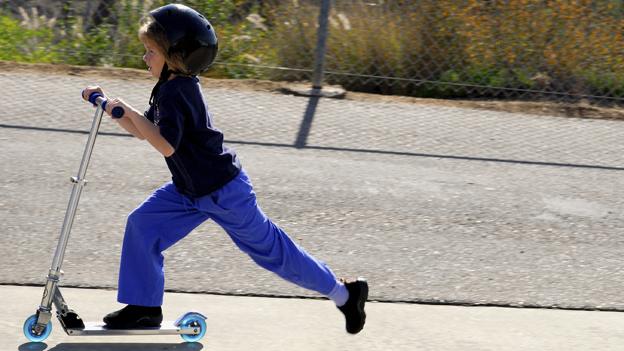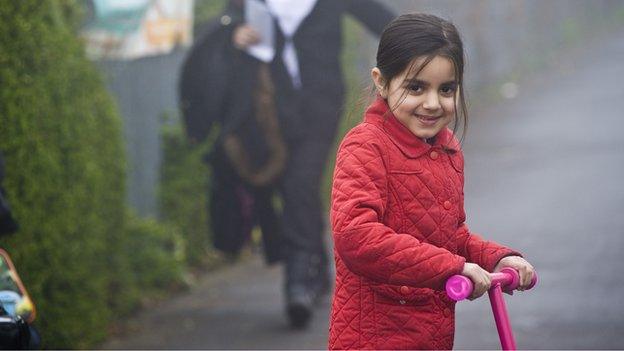How children's scooters transformed the school run
- Published
Four-year-old Arlo takes a tour of two south London parks on his micro scooter
Children's scooters have soared in popularity in recent years, but are they making life easier or harder for parents and pedestrians?
Getting the kids to school can be a pain. But at least it's becoming a speedier process. Children, often adorned with helmets, pads and high-visibility vests, are increasingly taking scooters to get to their classrooms.
According to a survey of 75,000 children by the transport charity Sustrans, external, the proportion of UK pupils regularly scooting or skating to school went up by more than half between 2013 and 2014, from 9.3% to 14.3%.
Amazon UK lists almost 3,800 children's scooters and related products, with scooters ranging from about £30 to £300 in price. Brands such as Street Cruz, Razor and iScoot sell models that are frequently souped up with stickers, bells, ribbons and rubber bands.
It's not just children who are riding them. BMX-style scooters with larger wheels, scooters with suitcases attached and stunt versions have appeared. Prime Minister David Cameron was photographed, external trying his children's scooter in London's Regents Park in 2013 and Hollywood star Hugh Jackman is a frequent user, external.
But it's younger riders who are increasingly noticeable. For parents, the appeal is obvious. Children often don't feel like walking, to put it mildly. A scooter is a fun distraction that allows a child to travel at an adult's pace.
The beauty of the scooter is the simplicity of its design. Its basic shape hasn't altered in more than a century and even small children can quickly learn to use a three- or four-wheeler.
The best known foot-powered - or "kick" - scooters are probably the Swiss-designed Micro Scooter range. About 10 million have been sold in 80 countries, the largest markets being Europe, the US, Australia and South Africa.
Schools - aware of the need for pupils to get more exercise - are encouraging scooting. Many provide specially designed storage racks and pods. And Sustrans is running its Big Pedal, external event from 2 to 20 March, which encourages teachers to get more children cycling and scooting to their classrooms.
It's exactly 10 years since mothers Anna Gibson and Philippa Gogarty took over the UK licensing of the Mini Micro, the three-wheeler version of the Micro Scooter for three- to five-year-olds. They first saw one while attending the One O'Clock Club for parents and children on London's Clapham Common.
"We needed something for the nursery run across the common every day," says Gogarty. "I ordered one for my son, who was about two at the time. Anna ordered another then another few for friends."
When Micro Scooters' UK distributor went bust the pair sensed an opportunity. They went to Switzerland and offered to take over. "They saw we were up for doing it," says Gogarty. "Our enthusiasm won through."
The UK business expanded quickly, with the John Lewis chain an early adopter. About 5,000 scooters were sold in 2005, rising to 65,000 by 2009.
Gogarty and Gibson persuaded Micro Scooters to develop another model, aimed at six- to 12-year-olds, which became the Maxi Micro. They now distribute the two-wheeled adult versions, too.
In fact, the brand started in 1996 as an adult mode of transport. Swiss banker Wim Ouboter devised the folding, two-polyurethane-wheeled aluminium model when he decided that a sausage shop in his home city of Zurich was too far away to walk to but too near to warrant driving, external, what he called a "micro-distance". The junior versions of the Micro, which don't fold but can be easily unassembled, followed.
While scooters help move children around more quickly, concerns have been raised over safety. In the US, the Nationwide Children's Hospital found last year that kick scooters had been responsible for 580,037 injuries, external between 2000 and 2011.
But this pales in comparison with the 1.35 million US children, external who visited accident and emergency wards with sports-related injuries in 2012 alone.
In New Zealand, figures supplied by the Accident Compensation Corporation show the number of child scooter-related injury claims increased, external from fewer than 1,000 in 2008 to more than 6,000 in 2012. Of these, 80% were caused by loss of balance or control and 10% by collisions. The most common injuries were cuts and soft tissue damage. Some 2% resulted in concussion.

History of the scooter
Thought to have originated in the late 19th Century - "Most scooters would have been homemade, using wood or whatever people could find. The simplicity of the design encouraged that," says Esther Lutman, assistant curator at London's Museum of Childhood, external
Surge of interest in the 1930s and, to a lesser extent, in the 1950s and 1980s
Trend for modern scooters dates from 1996, when Wim Ouboter of Micro Mobility Systems in Switzerland produced a foldable aluminium model

Scooter materials have changed over the last century but the basic design has remained similar

The UK government does not record scooter accidents on pavements separately from other pedestrian incidents, so there are no official figures.
Supporters of scooters say they offer something extremely valuable - freedom, countering the perceived tendency of many risk-averse parents to cosset their children indoors.
Gogarty says scooters create a "virtuous circle" of quicker journeys, more pleasurable experiences for children and parents, more exercise and the development of better fine motor skills.
Some people just find them annoying, though. "The mania for these dratted things means that high streets everywhere are now chock full of tiny people who act like they've been on the whisky," complains Guardian columnist Bella Mackie, external. And the Daily Mail's Amanda Hoyle, external says the extra convenience of a child moving more quickly on a scooter than on foot is more than offset by added danger. Some parents are displaying "arrogance", ignoring the risks those of primary school-age moving at speeds that can "reach 25mph".

Derek Smulders, who runs a safe scootering course for Central Bedfordshire Council's Travel Choices safety project, external, estimates most young children do not exceed 4mph on the pavement and usually stay at around parents' walking speed of 3mph.
Not that these gripes have made much impact. "There are a few sore-ankled naysayers who cite them as dangerous to life and limb and one of their biggest bug-bears, but clearly their popularity speaks for itself," says Justine Roberts, chief executive of Mumsnet, external.
Popular with parents and kids alike, the trend shows no sign of slowing down.

Scooter safety

Scooters should not be used where they will cause danger, fear or inconvenience to other people, or danger to the scooter user. Riders should be particularly careful on hills as scooters can pick up speed quickly, and scooter users should avoid using them in the dark as they do not have lights or reflectors and are difficult to see.
Scooters should not be used on the road - motorists will not be expecting to see them among traffic, and because they are so small (especially when ridden by children) they are difficult to see
Scooters should not be used on narrow or crowded pavements, or where they will cause inconvenience, fear or danger to pedestrians, especially elderly or disabled ones
Scooter riders need to keep away from areas where they are likely to come into conflict with pedestrians. A shopper walking out of a store will not expect to be confronted by someone speeding past on a scooter. A collision, particularly with an elderly person, could have serious consequences
Source: RoSPA, external

Subscribe to the BBC News Magazine's email newsletter to get articles sent to your inbox.